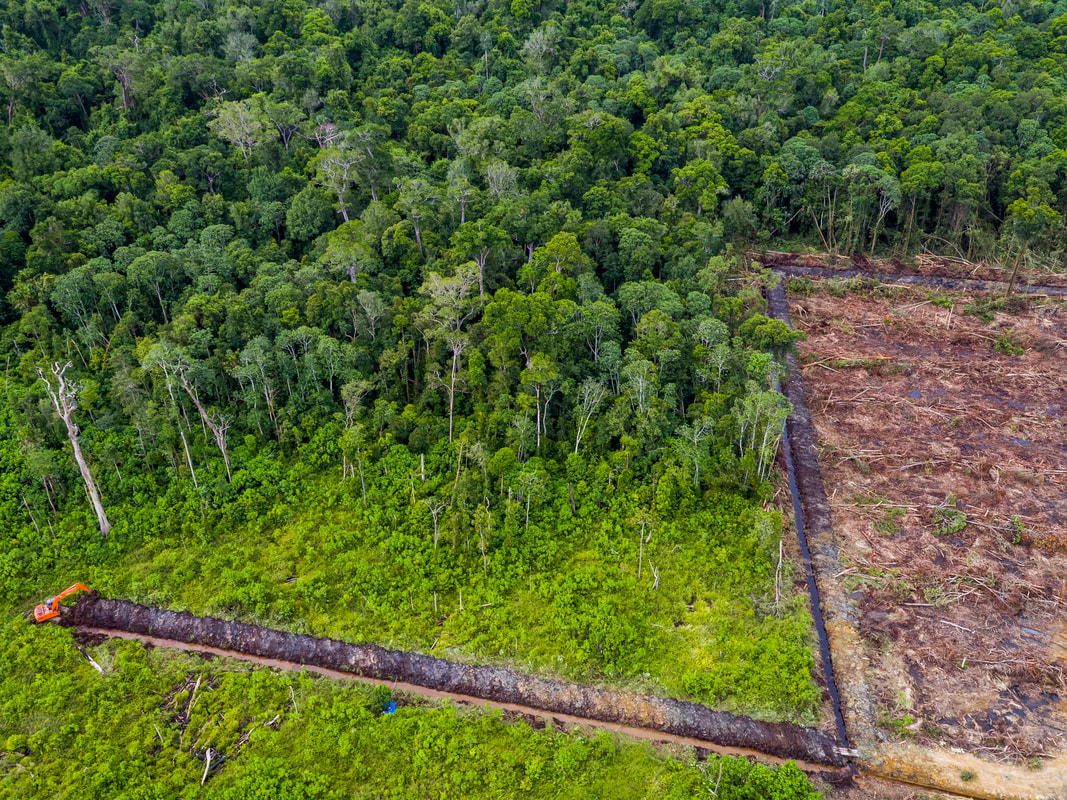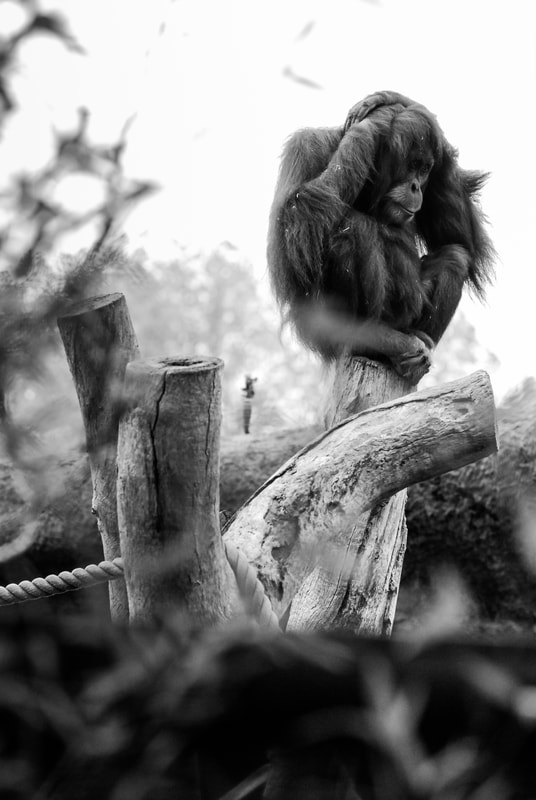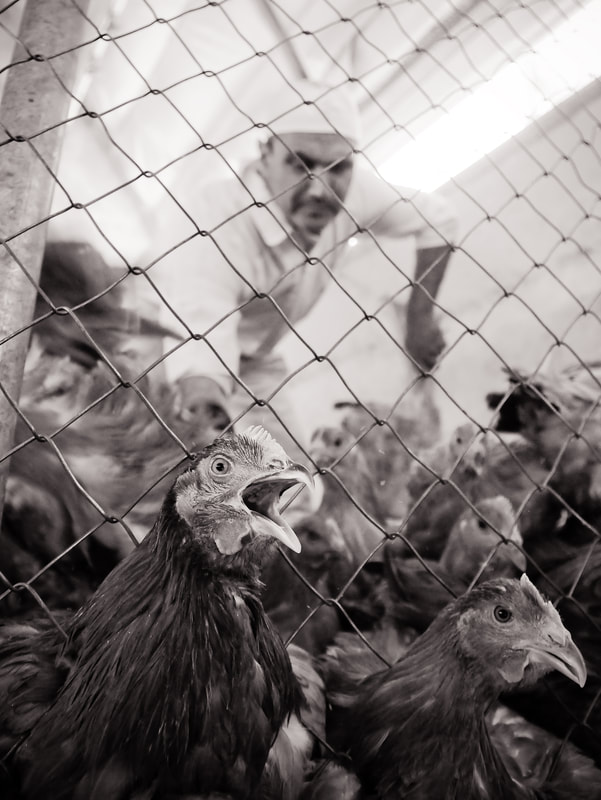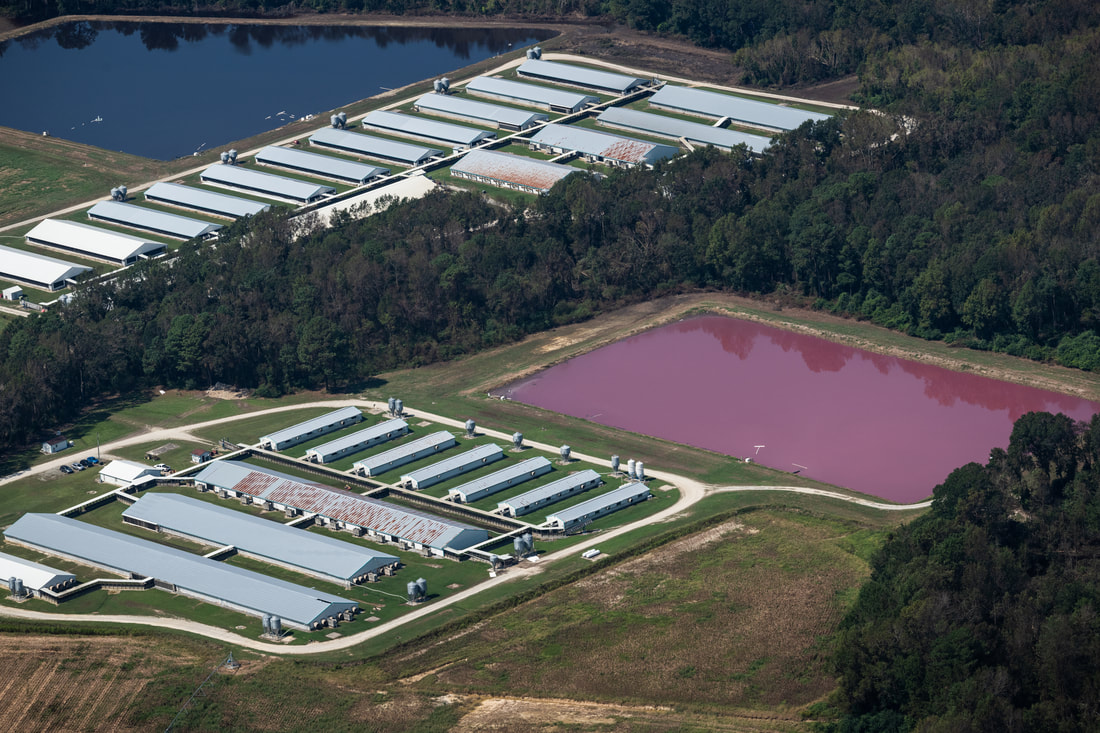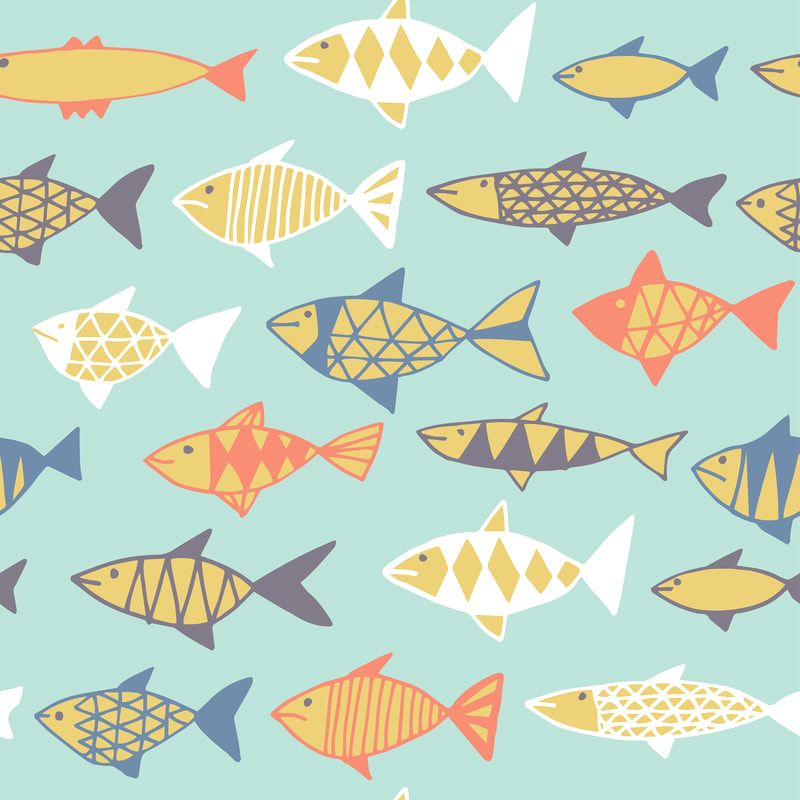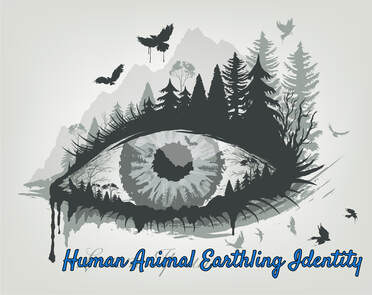Fostering Shared Values, Applied Universally
|
In this study of global social movement campaign messages, communication scholar Carrie P. Freeman recommends that all advocacy campaigns collectively foster a ‘human animal earthing’ identity around shared values supporting life, fairness, responsibility, and unity with other living beings -- framed biocentrically (not anthropocentrically) to support an inclusive 'total liberation of species.' This widens our sphere of moral concern and strengthens alliances across movements to mutually combat: the climate crisis, captivity/imprisonment and exploitation, extinction and deforestation, economic inequality, discrimination, violent masculinity, land grabbing, pollution, destructive farming and fishing, and threats to democracy.
|
ABOVE: An activist with Melbourne Pig Save provides water to a thirsty pig who is crowded in a transport truck in Australia, moments before his or her impending slaughter. Credit: Jo-Anne McArthur / We Animals.
|
How and Why to Reframe Values Biocentrically
An excerpt that highlights some scholarly input
"Crompton and Kasser (2009) suggest social justice activist campaigns can reduce discrimination against animals by reminding humans they are part of the animal kingdom and the natural world, while engaging people’s identities by valuing empathy and equality (values that should be applied to nonhuman animals too). A notion of interdependence with all living beings is key to developing an environmental identity (Clayton 2012) that increases people’s pro-environmental behaviors and their belief that nonhuman animals have rights and that other species’ interests should be included in decision-making (Clayton 2008).
To increase connection and reduce species- and race-based bias that can lead to dehumanization of any one deemed ‘different,’ studies have shown a benefit to eliminating the human/animal hierarchy by likening animals to us humans (Costello and Hodson 2010); ideologically, I also see the benefits of making the comparison in the other direction and likening humans to fellow animals, implying we should be flattered to have things in common with these amazing beings (Freeman 2010b). Advocacy in favor of a human animal earthling identity should blend continuity and diversity rhetorics, creating connections based on our kinship with animals while still appreciating diversity among species. In terms of connecting all human cultures, Castells (2010, 185) recommends blending “biological commonality” and “historical diversity” to foster a green culture—one that transcends nation-based identities toward a global identity necessary to solve global environmental issues; thus, green culture addresses both the ‘human’ and the ‘earthling’ aspect of the human animal earthling identity." (p. 208)
An excerpt that highlights some scholarly input
"Crompton and Kasser (2009) suggest social justice activist campaigns can reduce discrimination against animals by reminding humans they are part of the animal kingdom and the natural world, while engaging people’s identities by valuing empathy and equality (values that should be applied to nonhuman animals too). A notion of interdependence with all living beings is key to developing an environmental identity (Clayton 2012) that increases people’s pro-environmental behaviors and their belief that nonhuman animals have rights and that other species’ interests should be included in decision-making (Clayton 2008).
To increase connection and reduce species- and race-based bias that can lead to dehumanization of any one deemed ‘different,’ studies have shown a benefit to eliminating the human/animal hierarchy by likening animals to us humans (Costello and Hodson 2010); ideologically, I also see the benefits of making the comparison in the other direction and likening humans to fellow animals, implying we should be flattered to have things in common with these amazing beings (Freeman 2010b). Advocacy in favor of a human animal earthling identity should blend continuity and diversity rhetorics, creating connections based on our kinship with animals while still appreciating diversity among species. In terms of connecting all human cultures, Castells (2010, 185) recommends blending “biological commonality” and “historical diversity” to foster a green culture—one that transcends nation-based identities toward a global identity necessary to solve global environmental issues; thus, green culture addresses both the ‘human’ and the ‘earthling’ aspect of the human animal earthling identity." (p. 208)
How to Work Across Causes as Everyday Allies or in Coalitions
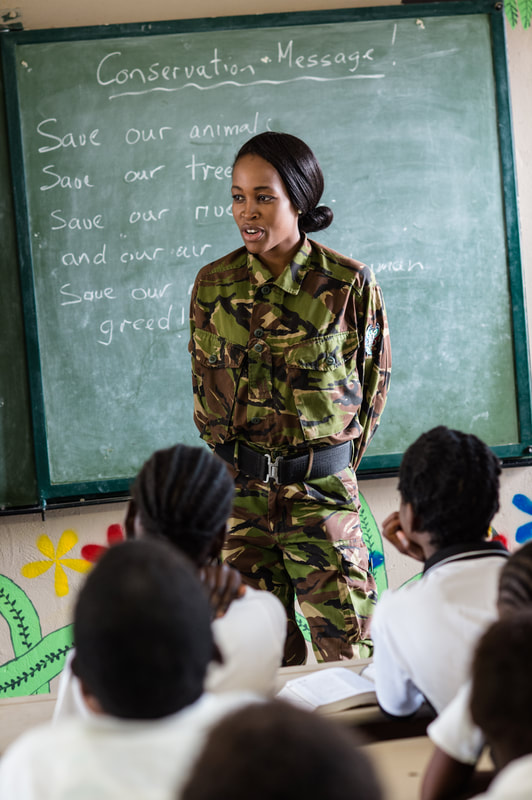 Siphewe Sithole teaching local school children during a classroom visit, part of the Black Mambas community education conservation program in South Africa. Credit: Jo-Anne McArthur / We Animals.
Siphewe Sithole teaching local school children during a classroom visit, part of the Black Mambas community education conservation program in South Africa. Credit: Jo-Anne McArthur / We Animals.
An important purpose of this book is to encourage the three causes—for animal protection, human rights, and environmentalism—to work as allies supporting one another in groundless solidarity (Colling, Parson, and Arrigoni 2014) for inter-species justice (Donaldson and Kymlicka 2016) and total liberation of species (Best 2014). (p. 211)
To be everyday allies, the 19 international activists interviewed in the book suggest that activists across causes must:
When working together in coalitions on common campaign goals (with agreed upon tactics and a shared vision of success), interviewees recommend that activists from different causes should:
To be everyday allies, the 19 international activists interviewed in the book suggest that activists across causes must:
- avoid myopic or narrow-minded thinking and perspectives;
- reframe issues to show respect to a wide variety of beings in campaign terminology, images, and tactics; and
- not use or objectify someone as a means to an end for your cause. (p. 211)
When working together in coalitions on common campaign goals (with agreed upon tactics and a shared vision of success), interviewees recommend that activists from different causes should:
- Build on one another’s strengths rather than focusing on differences. Don’t be too ideologically principled that you can’t find bridges to join with groups who have some similar interests (or similar opponents).
- Lead by example rather than trying to convert other activists to your cause. Build long-lasting relationships.
- Work with groups who have similar activism styles as you (in terms of matching radical to moderate approaches).
- Be bottom-up not top-down when working with local human communities, especially marginalized folks (practice inclusive decision-making), making sure they too benefit from the teamwork. (p. 221)
|
For human rights organizations, the main opportunities for inclusivity include showing some concern for individual animals and the natural world, which are affected by some of the same things threatening human well-being. (ex: highlight common mistreatment of all living beings by industries; acknowledge animal imprisonment and exploitation; avoid using fellow animals as gifts; and acknowledge human cultures are going extinct and so are nonhuman animal cultures).
|
For animal protection organizations to be more inclusive, there are opportunities to:
1) diversify the type of animals they emphasize in campaigns (such as including fishes, invertebrates, and other wildlife); 2) make greater connections with environmental issues (i.e. habitat degradation and overconsumption of shared resources); and 3) show parallels with human rights abuses by these same industries (such as worker safety or exploitation), without ranking oppressions. |
For environmental organizations, the main opportunities to be more inclusive are in adequately addressing issues impacting nonhuman animals (even individuals and species who aren't endangered), such as incorporating compassionate conservation principles and stridently critiquing animal agribusiness and commercial fishing. It's important that environmental justice for humans, especially indigenous & minority groups, continues to be an increasing area of emphasis in eco campaigns.
|
Thanks go out to these 19 global activist leaders interviewed in the book, so we can all benefit from their wisdom, experience, and engaged empathy:
- Mustafa Ali, Senior VP, Climate, Environmental Justice, & Community Revitalization, Hip Hop Caucus
- Emma Daly, Communications Director, Human Rights Watch
- Gnanapragasam Devadass, Deputy Director of Campaigns, Amnesty International
- Ginette Hemley, Senior VP Wildlife Conservation, World Wildlife Fund
- Ashfaq Khalfan, Director of Law and Policy, Amnesty International
- Frances Moore Lappé, Co-founder and Co-president, Small Planet Institute
- Lori Marino, Co-founder and President, The Whale Sanctuary Project
- Martin Lloyd, Senior Mobilisation Strategist, Greenpeace Netherlands
- Dawn Moncrief, Founder and President, A Well Fed World
- Ingrid Newkirk, Co-founder and President, People for the Ethical Treatment of Animals
- Sharon Núñez, Co-founder and President, Animal Equality International
- Erich Pica, President and CEO, Friends of the Earth USA
- Maria Rohani, Social Movements Advisor, CARE USA
- Carl Soderbergh, Director of Policy and Communications, Minority Rights Group International
- Laurel Sutherlin, Senior Communications Strategist, Rainforest Action Network
- Will Travers, OBE, Co-founder and President, Born Free Foundation
- Mark Tercek, President and CEO, Nature Conservancy
- Captain Paul Watson, Founder and President, Sea Shepherd Conservation Society
- Zoe Weil, Co-founder and President, Institute for Humane Education
